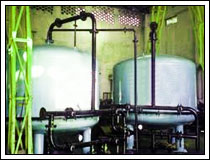Slow Sand Filters
A slow sand filter is the most commonly used type of sand filter. Sand filtration utilizes the filtering properties of sand and produces clean water that is perfectly safe for consumption. Moreover, as this process requires little or no mechanical power, chemicals or replaceable parts or even minimal operator training, butonly demands for some amount of periodic maintenance, it is the best option of water treatment for people living in the economically challenged and isolated areas.
Slow sand filters are generally seen in places where there is abundance of land and space and the water can be afforded to be passed very slowly through the filters. These sand filters are non-pressurized systems and use biological processes to treat water rather than physical processes.

Construction
Very high grade of sand are used while designing/fabricating a slow sand filter. The bed consists of the finest sand at the top, and a mixture of sand and gravel at the bottom. A very thin biological layer, called the zoogleal layer or Schmutzdecke is placed at the surface of the filter. The entire process of filtration depends upon this fine biological layer. The raw water is filled in from the top and the treated water comes out through drains at the base of the apparatus.
Depending upon the design of the pre-treatment, a sand filter may produce water with a very low available nutrient level which physical methods of treatment rarely achieve. Once the biological growth exceeds the permitted level and starts hindering the flow of water through the membrane, the top layer of sand is washed off and the filter is ready to be used again. Normally, in bigger sand filter models natural sediments from riverbanks are used to provide a first stage of contaminant filtration.
Although in most slow sand filters, cleaning is done by using a mechanical scrapper which is usually driven into the filter bed once it has been dried out, there are some filters that function on the basis of a method called wet harrowing. In this method, the sand is scraped while still under water, and the water used for cleaning is drained to waste.
|